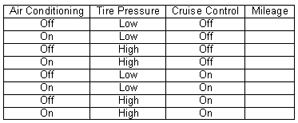Definition
The design and analysis of experiments is a statistical methodology used to test and determine the effect of various process Inputs on the process output. It takes a structured and scientific approach by making purposeful changes on several Factors simultaneously and measuring the resulting changes in the output of interest, thus teasing out the relationship between them. This approach is much more powerful and efficient as compared to the One Factor At a Time (OFAT) approach.
DOE starts with the development of a formal plan for conducting an experiment, including the choices of the response to measure, Factors to test, levels of the Factors and their combinations to be employed. Proper planning is the most critical step in conducting a successful designed experiment. The experimental design includes the treatment combinations or ‘recipes’ to be performed in random order with a new set of experimental material each time.
Examples

A typical design with three factors might look like this:
Application
One-hour recorded Webcast: "Experimental Design in the Transactional Arena"
External Links
American Society for Quality (ASQ) - Designed Experiments - http://www.asq.org/learn-about-quality/data-collection-analysis-tools/overview/design-of-experiments.html A Simple Explanation of Experimental Design: - http://helios.bto.ed.ac.uk/bto/statistics/tress2.html MoreSteam.com's Toolbox - Design of Experiments - http://www.moresteam.com/toolbox/design-of-experiments.cfm Experimental Designfrom the StatSoft Online Textbook - http://www.statsoft.com/textbook/stexdes.html
